Cheese Soda Bread Recipe
Cheese Soda Bread, with no kneading, proving time or yeast required, is a super-quick, soft, and moist cheesy loaf. It’ll take you less than 10 minutes to put together and bakes in half an hour.
If you’ve never made soda bread before, or if you’ve been disappointed with the taste and texture of other recipes, I think you’ll love this incredibly cheesy and light version.
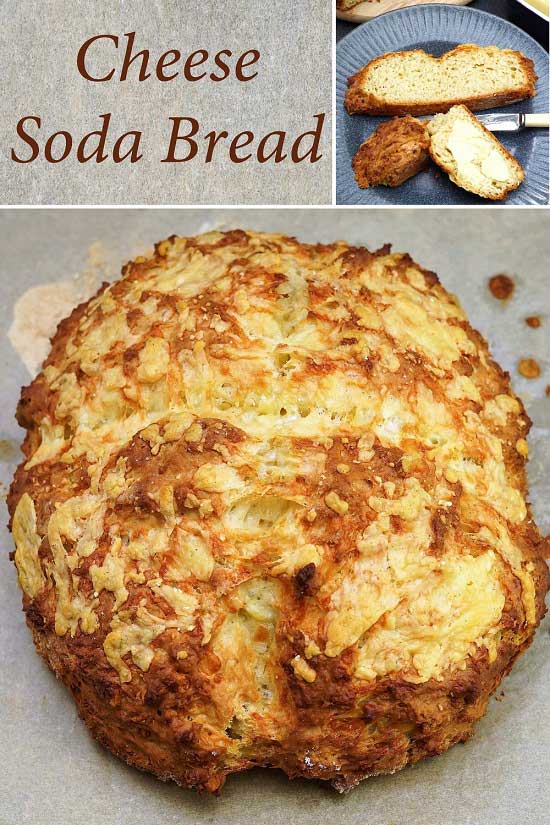
Perfect alongside soups, stews, or salads. Or just enjoy sliced and spread with plenty of butter. Lovely toasted too!
Jump to Recipe
I used to think I didn’t like soda bread. While the idea of a quickly made loaf was hugely appealing, my homemade efforts were always a let-down. Dense, heavy, somehow both hard and gummy at the same time. Add to that a strong metallic tang of soda and it hardly seemed worth it.
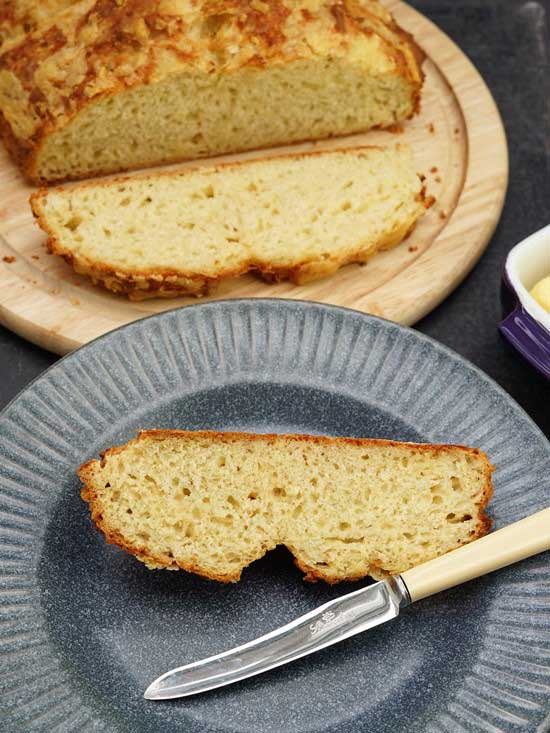
But I knew there must be a way of creating really good soda bread. So I started researching and experimenting. And I’m happy to say that I’ve cracked it. Cheese Soda Bread is light, deliciously tasty but still super quick and easy to make. I’ve also posted a recipe for a lightly sweet Fruit Soda Bread.
WHAT IS SODA BREAD?
Before I guide you through the simple steps of making Cheese Soda Bread, a word on what exactly soda bread is.
You might think it’s a very old and traditional type of bread, but it isn’t. That’s because chemical raising agents like bicarbonate of soda (baking soda in the US) and baking powder weren’t developed until the early nineteenth century. Prior to then, yeast would have been the only such addition to baked items.
Soda bread is known as a ‘quick bread’, and you shouldn’t expect the texture and taste to be the same as yeasted or sourdough loaves. But accept soda breads on their own terms, and you will enjoy the soft, almost cake-like texture – including that of savoury loaves like Cheese Soda Bread.
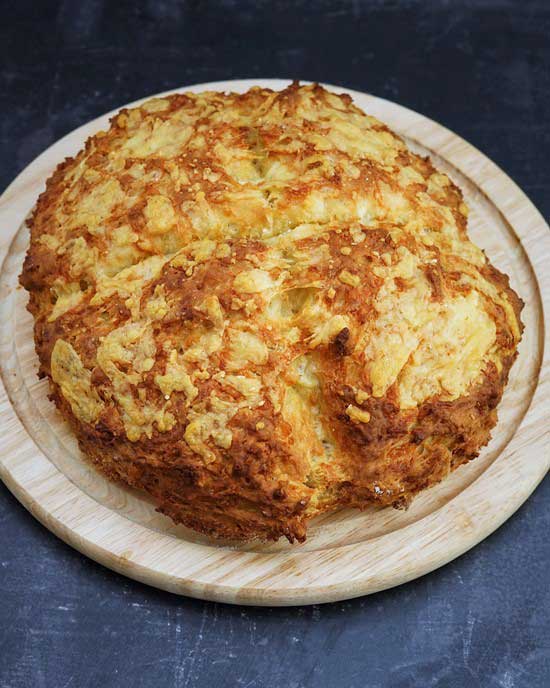
You need bicarbonate of soda to make soda bread and not baking powder. Baking powder is a combination of bicarbonate of soda (which is alkaline) plus an acid such as cream of tartar. When mixed with liquid, the baking powder creates gas, causing the bread to rise.
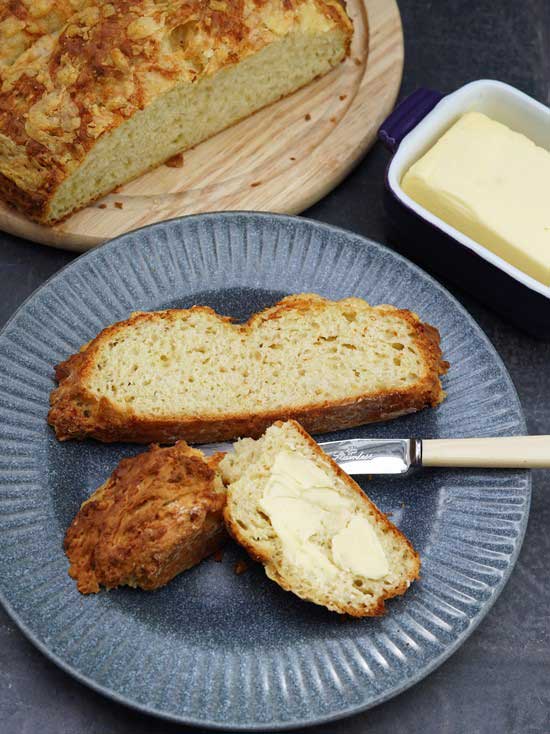
However, with soda bread the gases are created by the baker mixing an acidic liquid with the alkaline bicarbonate of soda. Traditionally, this would have been buttermilk or sour milk. As we’ll see, my preference is to use a mixture of yogurt and milk instead. It’s also possible to use milk mixed with lemon juice or vinegar for a similar effect.
TIPS FOR LIGHT & FLUFFY, GREAT TASTING CHEESE SODA BREAD
In her English Bread and Yeast Cookery (1977) Elizabeth David points out, via a quote from a nineteenth century cookery book, that half a dozen different people could use the same soda bread recipe but end up with ‘very variable specimens of bread’. That’s because much comes down to technique and speed.
I’ve found that there are THREE important things to getting a light and fluffy, great tasting soda bread.
1. Work fast. As soon as the soda is mixed with liquid it will start working, creating the gas that will make the bread rise. So put your skates on and get the bread into the oven within a few minutes.
2. Handle the dough as lightly as possible. Absolutely zero kneading because this will make the bread harder, not lighter. In my recipe we don’t touch the dough at all with our hands.

3. Mix the ingredients well. It’s important that the bicarbonate of soda is thoroughly mixed with the liquid and throughout the dough. Otherwise, you might get an unpleasant metallic taste or even discoloured patches (albeit harmless) in the finished bread.
INGREDIENTS FOR CHEESE SODA BREAD
As the steps go very quickly, start by having all your ingredients weighed out, prepped and ready to go.
- Plain white flour. For Cheese Soda Bread I prefer white flour. You could swap in some wholemeal, but you won’t get such a good rise. Note that we don’t need bread flour. Just ordinary plain.
- Bicarbonate of soda. Raising agents can lose their power quickly once opened. If yours has been open for more than six months, even if it’s within the Best Before date, consider buying a fresh pack. To ensure you don’t use too much, swipe the blunt edge of a knife across a teaspoonful to remove excess.
- Salt. I use just less than a teaspoon.
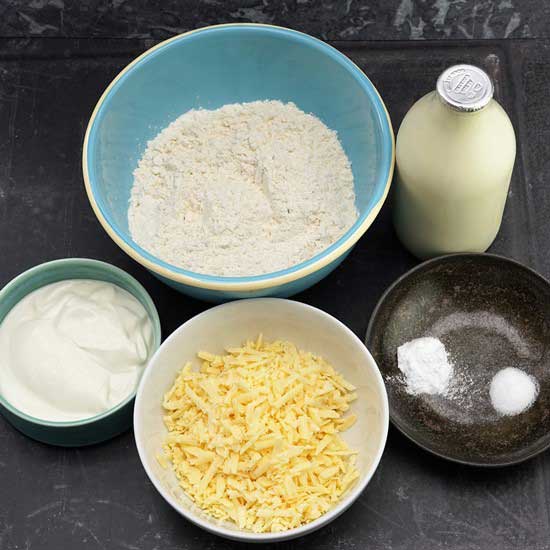
- Cheddar cheese. For the best tasting Cheese Soda Bread, use plenty of strong, mature Cheddar.
- Yogurt and milk. I find that the best soda breads are where the liquid element is half plain yogurt and half milk, stirred together. As well as providing the acidic element needed to get the bicarbonate of soda working, I think the combination makes a particularly light and fluffy bread (as well as excellent cheese scones and sultana scones). Although buttermilk was traditionally used, this is generally not so easy to come by. It’s also more expensive. Alternatively, you could use a tablespoon of lemon juice or white vinegar mixed with 250ml of milk, left at room temperature for 10 minutes, but note that the final result may not be exactly the same.
Some recipes for soda bread include eggs and butter. But I think these are unnecessary and take us too far into the realms of cake rather than bread.
The ingredient amounts given in the recipe card at the end make one small Cheese Soda Bread. This should feed four to eight people depending on appetites and what you’re eating it with.
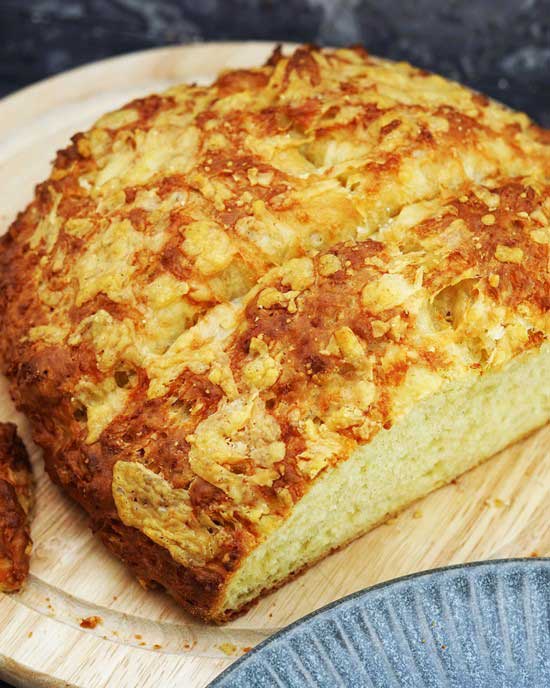
Although you could double up the ingredients to make a large loaf, I recommend sticking with a small one for the best results. Otherwise, the outside could be cooked while the middle is unpleasantly gummy.
EASY STEPS TO CHEESE SODA BREAD
Before you get started, preheat your oven with a shelf positioned in the middle. To avoid the bread sticking, line a baking tray with baking paper and sprinkle it with a little flour.
STEP 1.
The first step is to combine the flour, bicarbonate of soda, and the salt. To make sure they’re evenly mixed, I stir them together then sift into a large bowl.
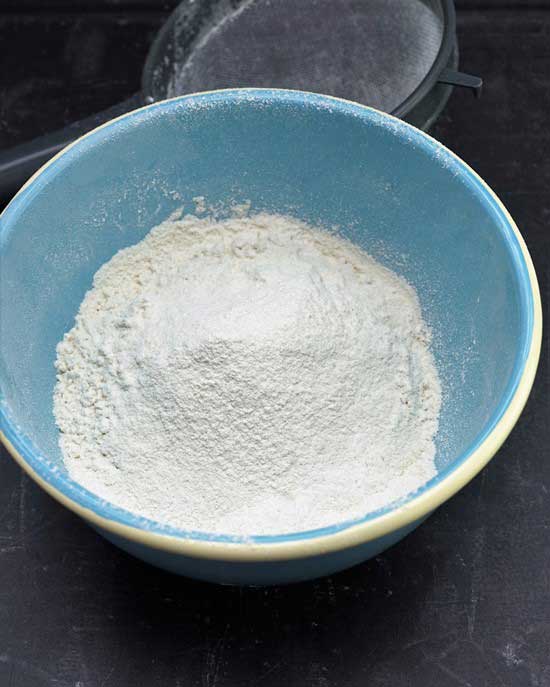
STEP 2.
Next, stir in 125 grams of the grated, strong Cheddar cheese.
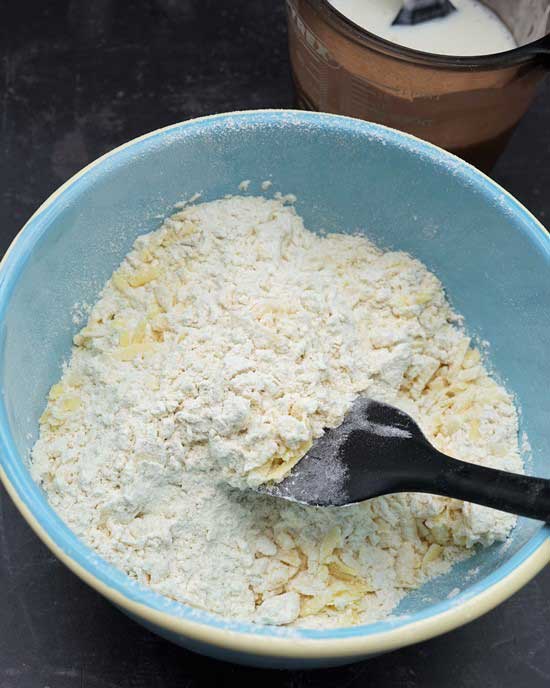
STEP 3.
Make a well in the centre and pour in approximately three quarters of the yogurt and milk. Different flours absorb different amounts of liquid so you may or may not need all of that stated in the recipe.
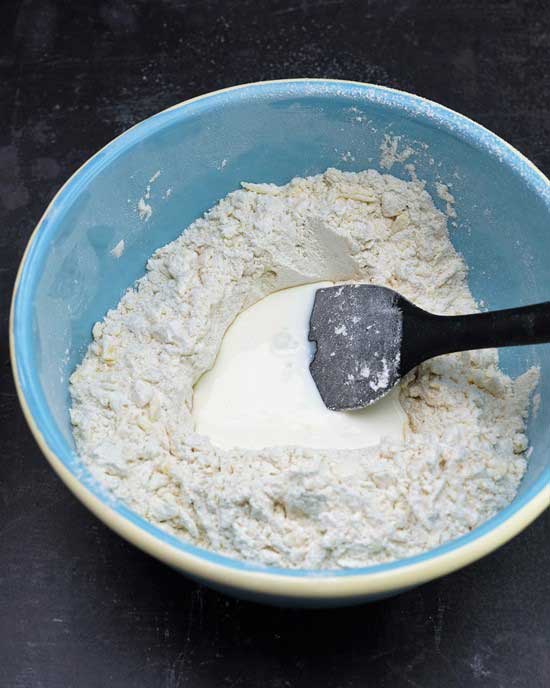
The important thing is that you create the correct dough texture. It should look quite wet and shaggy. Use a plastic spatula or spoon to bring the flour, cheese, and liquid together, adding more liquid as needed.
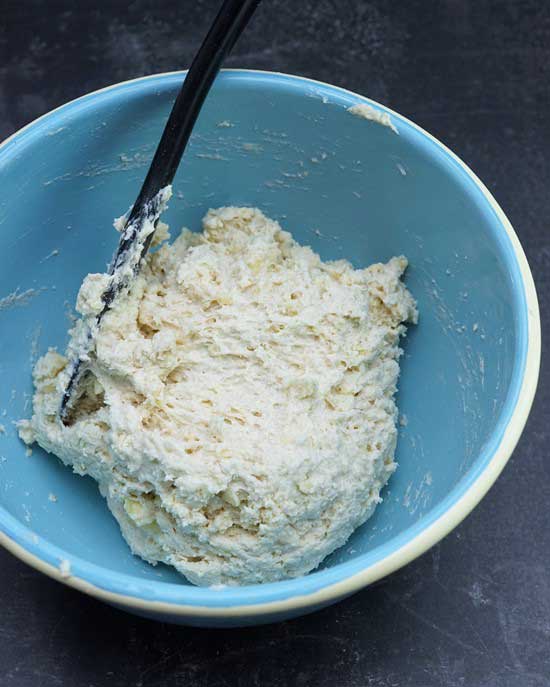
Work fast but mix very thoroughly: if there’s any bits of bicarbonate of soda left unmixed with the liquid then, once baked, it will give an unpleasant metallic taste to the bread.
STEP 4.
Now scrape the dough onto the middle of the floured baking paper on your prepared baking tray.
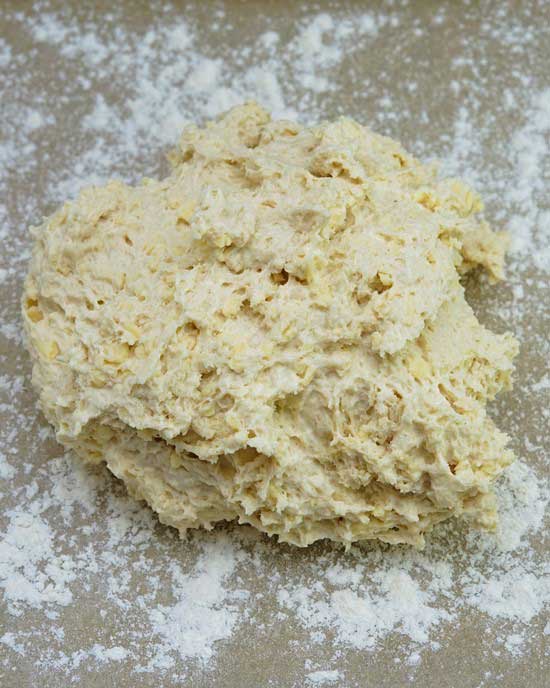
STEP 5.
Use a palette knife or similar, dipped in flour, to pat and shape the dough into a round approximately 14 centimetres in diameter.
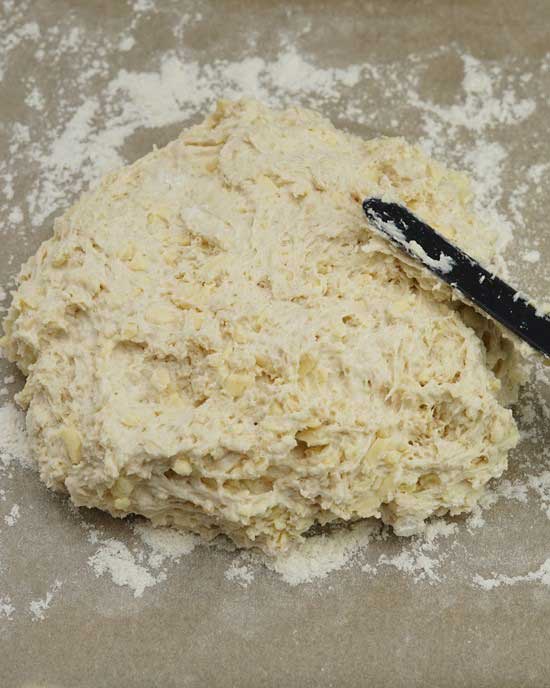
STEP 6.
Take a sharp knife, dipped in flour, and cut a deep cross into the dough but don’t go all the way through. This helps to quickly cook the centre. It also means the finished bread can be easily pulled apart into the traditional quarters rather than slicing if liked.
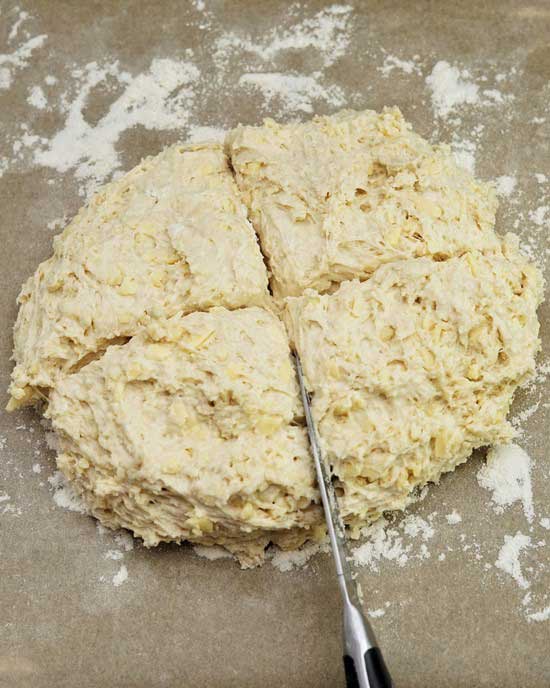
STEP 7.
Sprinkle generously with more grated strong Cheddar cheese.
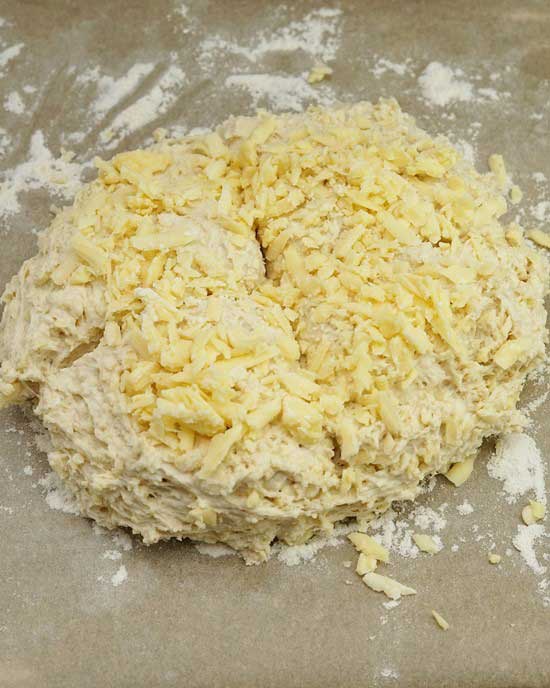
STEP 8.
Put in the preheated oven and bake for approximately 30 minutes. The Cheese Soda Bread should be well risen, dark golden in colour and sound hollow-ish when tapped on its base.
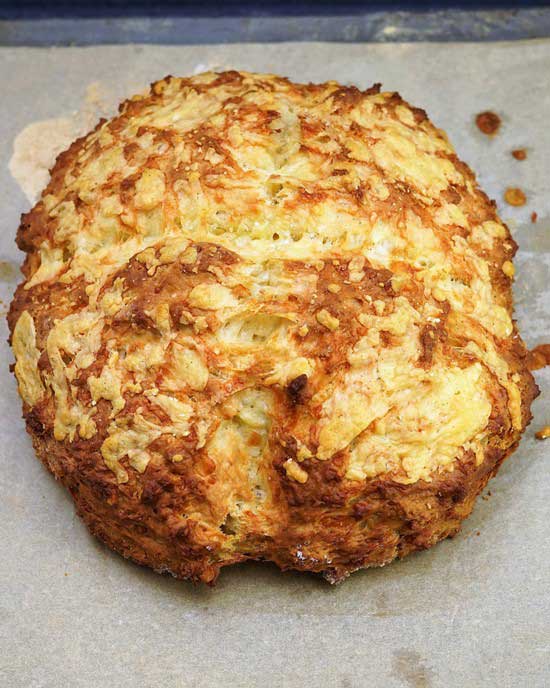
SERVING CHEESE SODA BREAD
While it’s tempting to dig into this wonderful smelling, great looking bread straight away, I think the texture is much nicer if left to cool.

If you’re used to eating heavy, drier soda breads, my Cheese Soda Bread should be a revelation. Soft, light, and full of delicious cheesy flavour.
My favourite way to eat it is the same as for my Very Cheesy Cheese Scones: sliced and thickly buttered. Perfect for a snack or as part of a savoury afternoon tea. Of course, soda bread is a traditional accompaniment to soups and stews and my cheesy version makes that combination extra special.
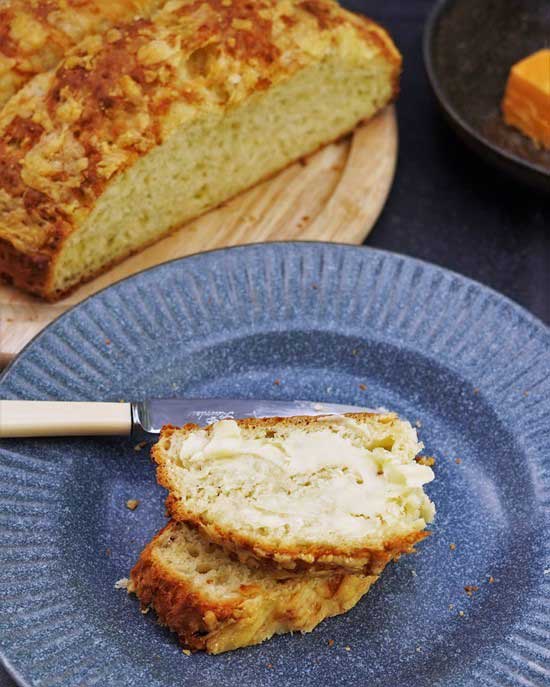
It’s often said that soda bread should be eaten on the day of making as it stales quickly, although it can be frozen. However, I’ve found that stored in a polythene bag Cheese Soda Bread is still light and fluffy the next day. It’s also fantastic toasted as the cheesiness is intensified even more.
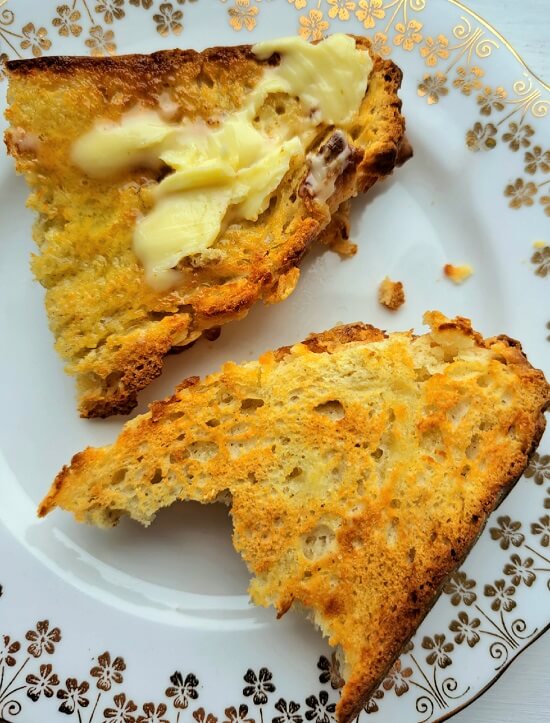
With this super-easy recipe, it would be fun to do some experimenting. Try ringing the changes by stirring in with the cheese some chopped spring onion, a few seeds such as sunflower or pumpkin, dried herbs, or spices e.g. smoked paprika.
If you’ve made my Cheese Soda Bread, I’d love to know what you thought. Leave a comment and don’t forget to rate the recipe.
For a lightly sweet version, see my Fruit Soda Bread recipe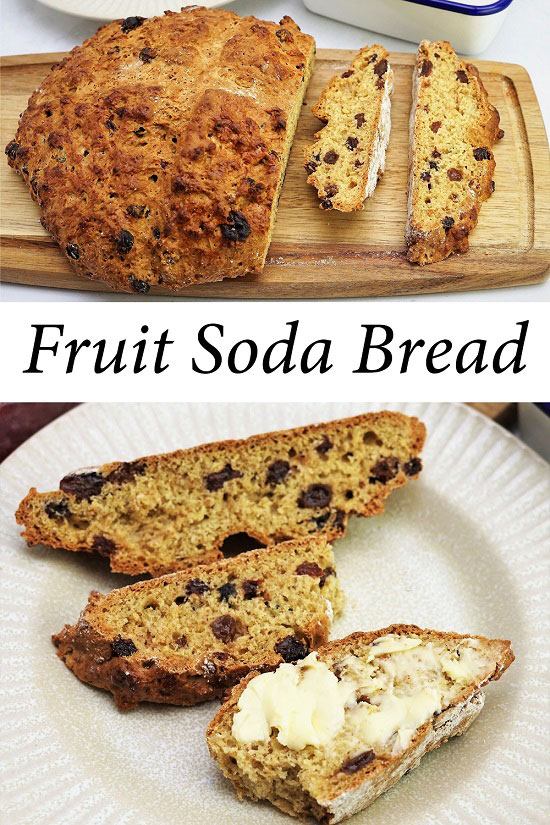
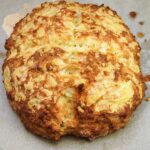
Cheese Soda Bread
This light, soft and deliciously cheesy version of soda bread is so quick and easy to make.
Serve sliced with butter or in chunks alongside soups, stews, salads etc. Great toasted too!
For a well risen, light and fluffy result, work quickly and don't handle the dough too much.
Ingredients
- 125 ml plain yogurt see Recipe Note 1
- 125 ml milk see Recipe Note 1
- 300 g plain white flour (plus extra for sprinkling) see Recipe Note 2
- 1 level tsp bicarbonate of soda see Recipe Note 3
- ¾ tsp salt
- 150 g strong mature Cheddar cheese grated and divided 125g/25g
Instructions
-
Preheat your oven to 200c / 180 Fan / Gas 6 with a shelf in the middle position.
Line a baking tray with baking paper and sprinkle it with flour.
-
Stir together the yogurt and milk.
-
Stir together the flour, bicarbonate of soda and salt.
Sift it into a large mixing bowl.
-
Stir 125g of the grated cheese into the flour mixture.
-
Note: from this step until you put the bread in the oven it's important to work quickly. The bicarbonate of soda is activated as soon as it's mixed with the liquid so try to get it in the oven within 3-4 minutes.
Make a well in the centre of the flour then pour approximately 3/4 of the yogurt and milk mixture into it.
Stir to combine into a wet, ragged dough, adding more of the liquid as needed. You may not need all the liquid, but make sure there are no dry bits of flour as this can affect the taste and even the colour of the finished loaf.
-
Scrape the dough onto the middle of the baking paper.
Use a palette knife or similar, dipped in flour, to push the dough into a circle approximately 14 cm in diameter.
Dip a sharp knife in flour and cut a deep cross into the dough without going all the way through.
Sprinkle the top with the remaining 25g of cheese.
-
Immediately put in the oven and bake for 30 minutes (turn around halfway through if your oven cooks unevenly) or until the bread is risen, deep golden in colour and sounds hollow-ish when tapped underneath.
-
Transfer to a wire rack to cool before slicing and serving spread with butter or torn into chunks to serve with soup, salad, etc.
Best eaten within 2 days or can be frozen. Excellent toasted and spread with butter on the second day.
Recipe Notes
Note #1 Liquid. To activate the bicarbonate of soda which causes the bread to rise, the liquid needs to be acidic. I get best results using half plain yogurt and half whole milk. Although you can replace this with buttermilk OR 1 tablespoon of lemon juice stirred into milk and left for 10 minutes, the results may not be exactly the same.
Note #2 Flour. You can replace some or all of the white flour with wholemeal if you prefer. However, soda bread made with wholemeal will usually be flatter. Plain flour, not bread flour, should be used for soda bread.
Note #3 Bicarbonate of Soda. Do not use products labelled baking powder for soda bread, only bicarbonate of soda (or baking soda in the US). If your pack has been open for more than 6 months, even if it's within the Best Before date, it's probably best to replace it. Don't be tempted to use more than stated in the recipe: level a teaspoonful by drawing the flat edge of a knife across it to remove excess.
RELATED RECIPES

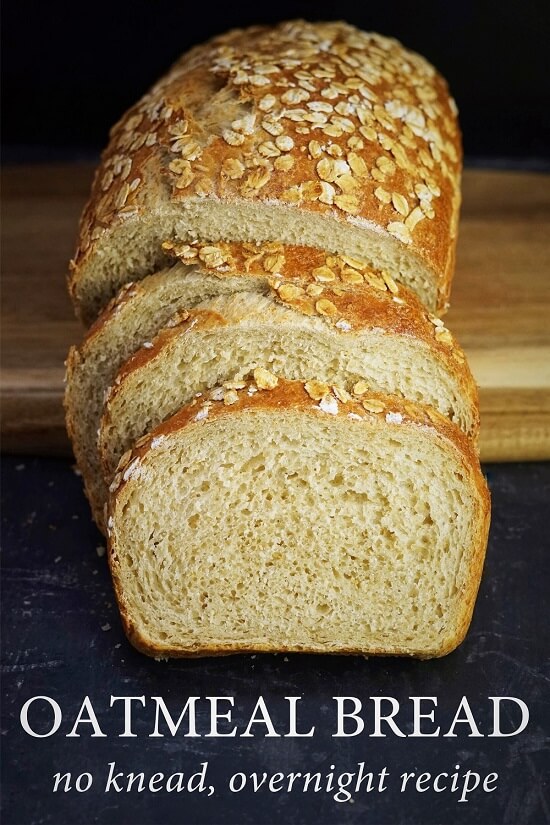
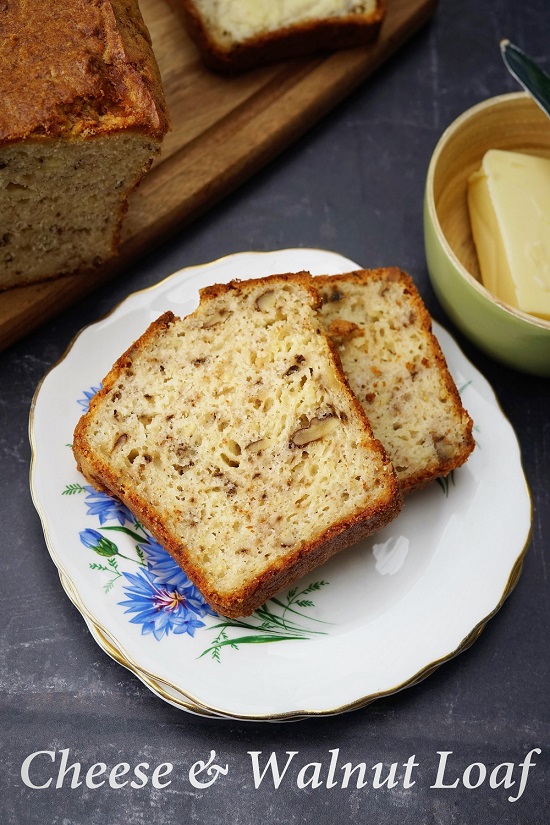
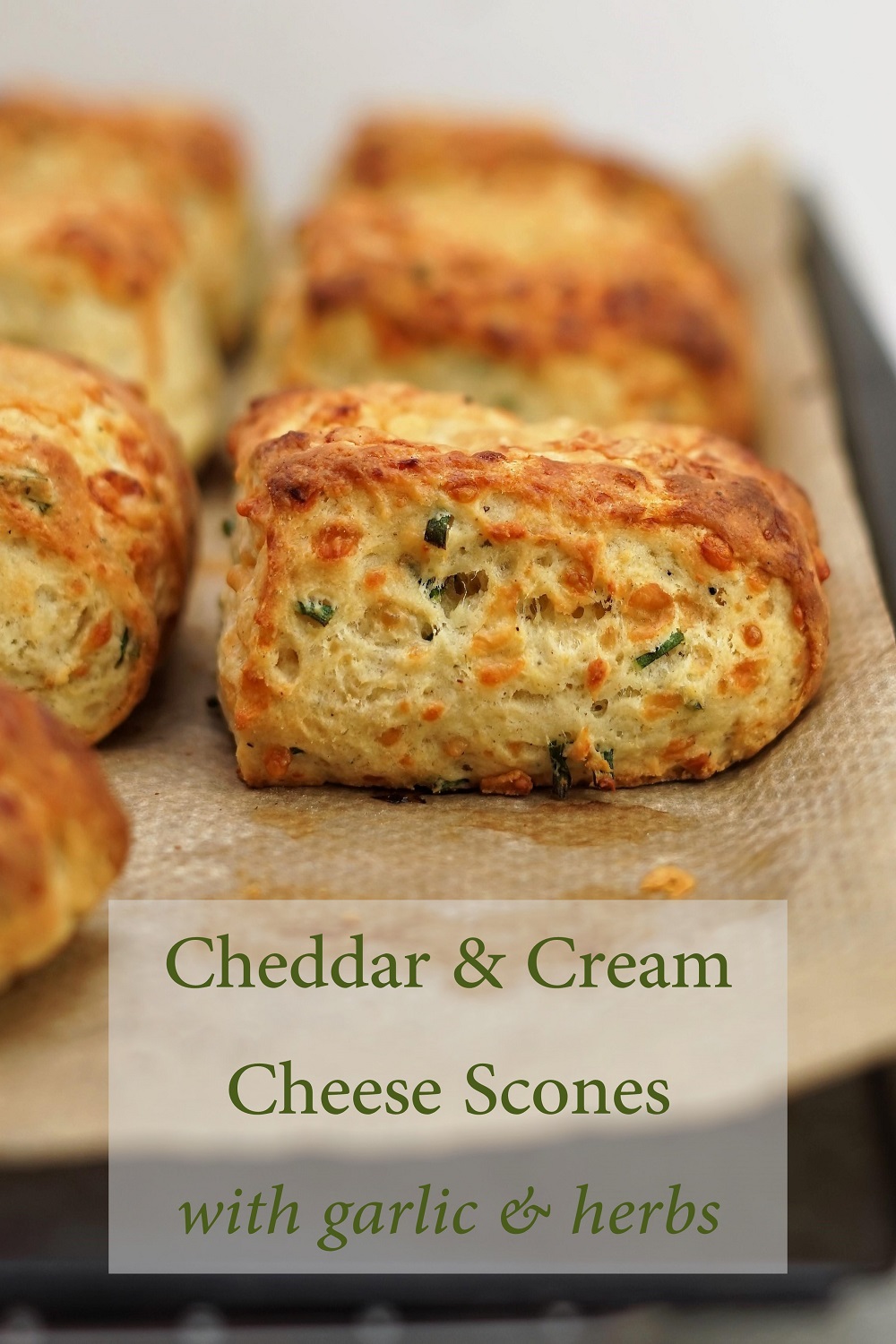

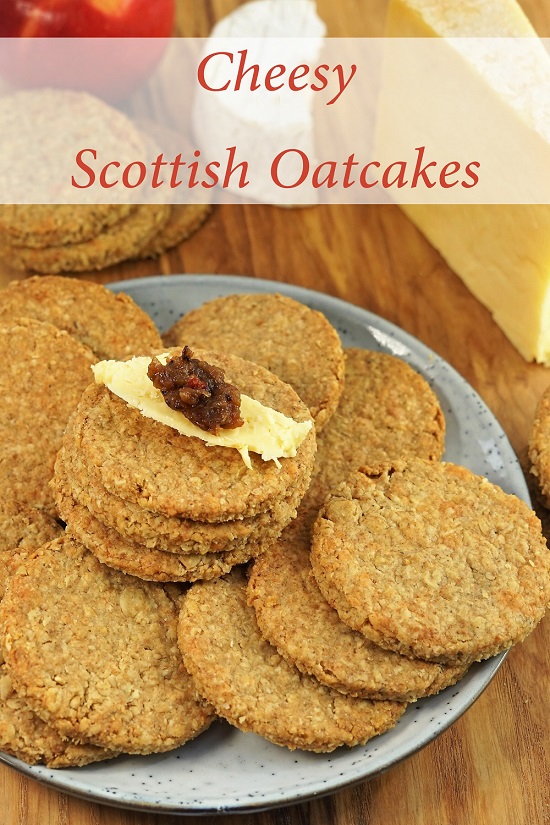
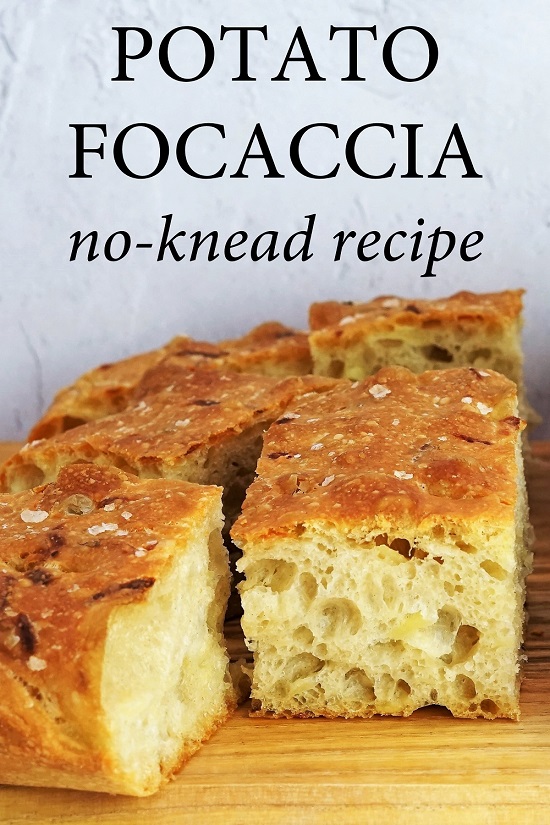
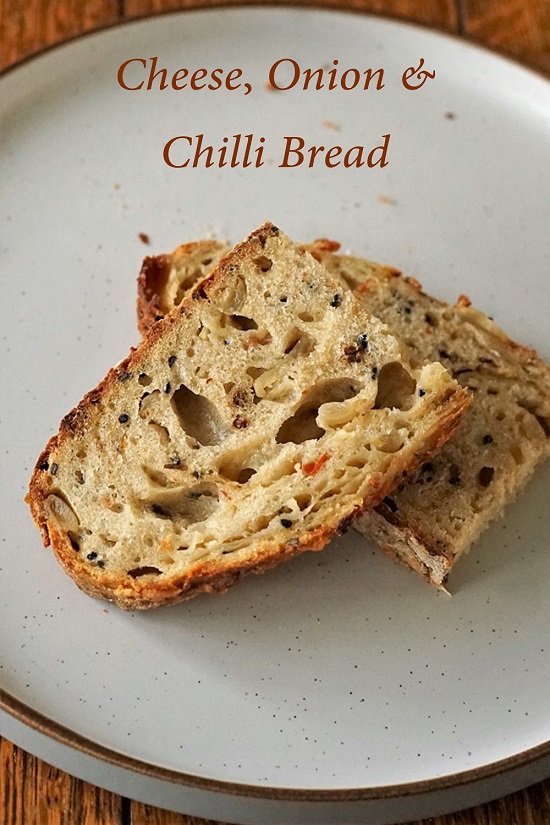
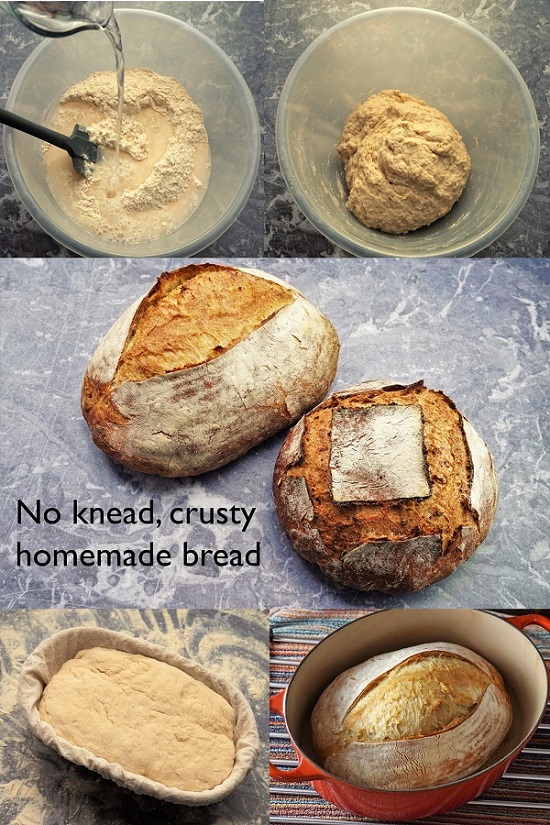
Hello, do you think it would work making this into individual rolls and would you reduce the cooking time for that? thanks!
Hi and many thanks for your interest in my recipe! Yes, this should work as individual rolls, although I haven’t done it myself. I suspect they would take a similar time to my Very Cheesy Cheese Scones which is 13 – 18 minutes, depending on how many rolls you made.
Do come back and let me know how it went if you give them a try!
Just a slice for tea ended up being half a loaf! Amazing recipe, I used Matthews Cotswold White Spelt flour, Yeo Greek style yoghurt and lactose free semi skimmed milk, the cheese was low fat mature cheddar. Worked perfectly, tasted divine! Thank you so much, going to try more of your recipes now 💚
Thank you for the lovely feedback! So pleased you enjoyed my recipe ☺️
So, I had kind of a weird issue with this recipe – I added the whole 250mL of milk+yogurt and it wasn’t enough to get a wet dough with
Feeling the pressure of the bolded note abiut now being speedy, I briefly dithered about shoving my hands in to see if I could redistribute the moisture enough vs adding more – wound up adding about 1/3 cup more milk (figured mixing with yogurt would take too long) to achieve a slightly sticky dryish drop-biscuit textured dough. It cooked up just fine, not the amazing cheese quickbread I admit I dreamed of but totally acceptable and my husband has already inhaled most of the loaf. I keep going back over the recipe and can’t figure out why I had this problem UNLESS plain white flour could be something other than all purpose flour? Or maybe my interpretation of “wet, ragged dough” is wetter than other people’s? I can’t even blame environmental variation for needing more moisture since far from the air being dry, it’s pouring buckets today!
Hi there! as far as I know all purpose flour IS the same as what we call plain flour. Although different flours (even different batches of the same flour) can absorb different amounts of liquid, I’m still surprised you had to add a fair bit more than suggested. Did you weigh the flour and not convert to cups? I ask because you mention a third of a cup of milk.
If not, the only other thing I can think of is that, as you say, your idea of what is a wet dough is rather wetter than mine. In the blog post there’s an image of what it should have looked like.
Thanks for trying my recipe and I’m glad it seems to be enjoyed anyway!
Thanks for replying! Yep, I weighed out the flour. I’m just used to looking at the cups rather than mL side of the measuring cup for liquids, sorry! Even with the added milk, mine appeared drier than in the photo. Bizarre!
Yes, it is strange! I also have a fruit soda bread recipe with the same ratio of liquid to flour which works perfectly for me too. I guess it must be then that you have a particularly thirsty flour.